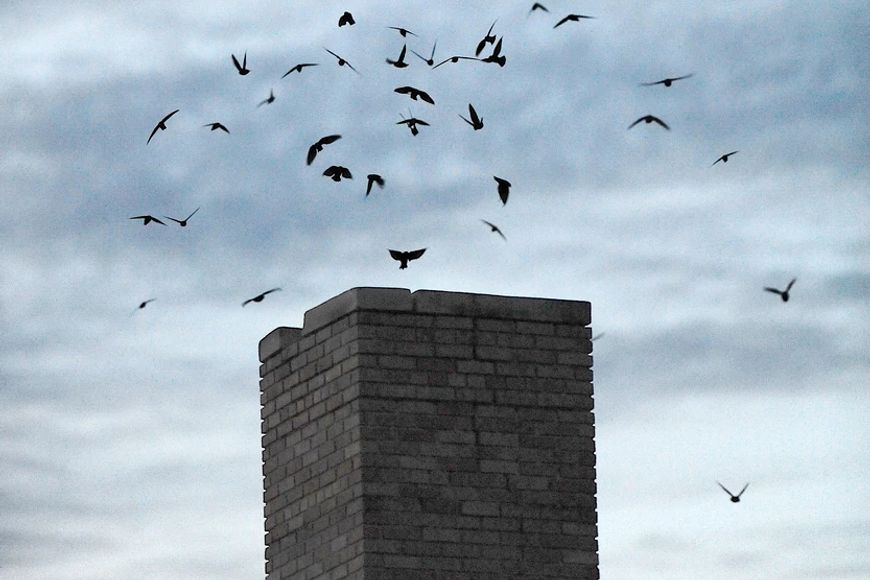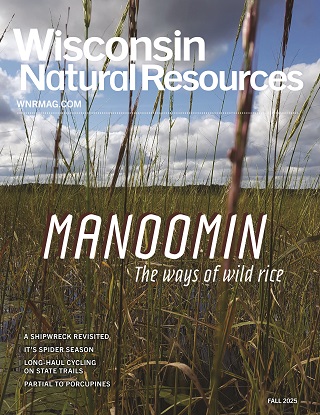Contact: Rich Staffen, DNR Natural Heritage Conservation Biologist
richard.staffen@wisconsin.gov or 608-266-4340
Nancy Nabak, Communication & Development Coordinator,
Woodland Dunes Nature Center
nancyn@woodlanddunes.org or 920-793-4007
DNR Asks Public To Help Count And Track Declining Chimney Swifts In Wisconsin
Chimney Swift Counts Help Identify Critical Roosting Sites For The Species
 A group of chimney swifts circles their roost.
Photo credit: iStock/Jim Williams
A group of chimney swifts circles their roost.
Photo credit: iStock/Jim Williams
MADISON, Wis. – The Wisconsin Department of Natural Resources (DNR) asks the public to report chimney swift sightings to help monitor trends and locate important roost sites.
While migrating through Wisconsin from mid-April to early May from their winter homes in South America, you can find large numbers of chimney swifts and hear their chittering sounds in the early evenings, ready to roost overnight in brick chimneys. Some will stay in the area to breed, and others will go farther north.
"It's pretty easy for anyone to identify a chimney swift. They have slender bodies with long, curved wings and a short, tapered tail – they look like a flying cigar," said Rich Staffen, DNR Natural Heritage Conservation biologist. “They fly rapidly, often twisting from side to side and banking erratically. They also give a distinctive, high chittering call while in flight. Chimney swifts are the only bird that will roost in a chimney, dropping inside at dusk and emerging the next morning.”
According to the latest North American Breeding Bird Survey from the USGS Patuxent Wildlife Research Center, the chimney swift population has declined by 72% in the past 50 years. By continuing to monitor these populations, the Wisconsin Chimney Swift Working Group, a statewide volunteer effort to keep swifts common in Wisconsin, hopes to learn more about them, identify important roost sites and find ways to help protect them.
"Spring is an excellent opportunity to gauge chimney swift population numbers and help assess trends for this species. It's a simple process; you don't need to be a bird expert to do this. All you need to do is count," said Barbara Duerksen, a member of the Wisconsin Chimney Swift Working Group. "Counting swifts is important because their numbers are declining. We've been doing this for years in the fall, but we're now encouraging folks to watch and count in the spring."
Here's how you can help:
- Watch and listen for chimney swifts during the day while they hunt for insects. They may appear in the southern half of Wisconsin from late April to early May and in the state's northern half soon after that.
- Look for tall brick chimneys that are uncapped. If you find more than one chimney, do some scouting in the evenings to determine where the swifts will roost. Watch for swifts swooping over the chimney for a while before they enter. Be aware that the roost site choice can change from night to night, especially during migration.
- Pick one or more nights to monitor in May. Larger numbers show up two or three weeks after the first swifts arrive.
- Observe the roost starting roughly 20 minutes before sunset until 10 minutes after the last swift enters the chimney. Stay in one location, even if you do not see swifts right away. They may come to your site later, and you do not want to miss them. To be sure, stay 30 minutes after sunset to know if it was active or not. If you have zero swifts in your chimney, please record this because it is still valuable information.
- Count (or estimate) the number of swifts as they enter the chimney. It's useful to count in groups of five or 10 when they enter quickly in large numbers. A handheld clicker counter can be helpful.
- You can continue your count at large chimneys throughout the breeding season if many individuals continue to use these roost sites.
- Submit your data to eBird.org. Please note that a free eBird.org account is required to log in and submit your data. Map your roost site to an exact address or point when prompted for a location. After you enter the number of chimney swifts, use the hashtag #SwiftWI in the chimney swift details section, making your data submission easier to access.
- You can add additional information in the chimney swift details section, in this exact order, with semicolons separating the data: #SwiftWI; the type of building (residence, school, church, business, hospital, apartment, swift tower/structure, etc.); the condition of the chimney (in good shape, in need of repair); any other notes. (Example: #swiftwi; residence; chimney in need of repair; any other notes.)
Find more information about chimney swifts and how to help protect them locally, on the Wisconsin Chimney Swift Working Group website

